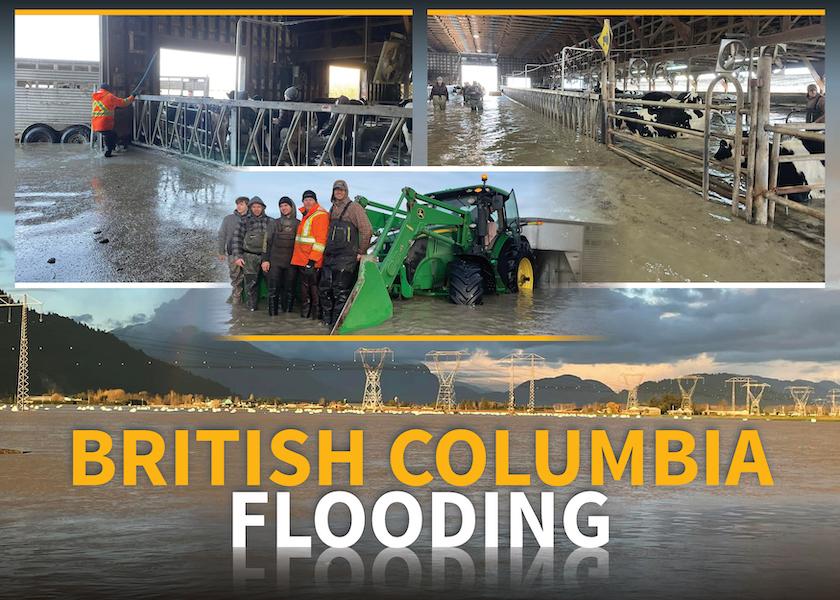Flood Update from Canada: “When We Got to the Calves, They Were Up to Their Chins in Water”

Canadian dairy farmers have recently been hit hard due to torrential rains that pummeled parts of western Canada’s British Columbia. Some areas of the province received a month’s worth of rain in two days, causing severe flooding and mudslides. These extreme events have forced thousands of people, including numerous dairy farmers along with their animals, to evacuate.
Richard Bosma, a dairy farmer in Abbotsford, British Columbia, is just one of the many farmers in the area who was forced to get out.
“The police knocked down our door at 6 a.m. on Tuesday telling us to evacuate, and we said we couldn’t because we have cows. So, we watched the water get closer and closer. It stayed kind of at the same level for a long time and it stabilized for a bit, but then it came across the road, which is the high point, and it kept coming and was speeding up,” Bosma says.
With the water rising and barns quickly beginning to flood, Bosma was thankful he was able to rely on his friends and neighbors to help rescue his animals.
“People came with cattle trailers, and we were able to get the milk cows out first. When we got to the calves (in the calf barn), they were up to their chins in water. We left the young animals [heifers] on wet packs and planned to get them out the next day,” he noted.
However, flood levels were continuing to rise, and the Barrowtown Pump Station used to divert water into the Sumas River was being overwhelmed by the floodwaters.
“Around 7 p.m. that night, they informed us the big pumps were about to fail because they were going to be underwater. They had a huge crew of 200 people who were sandbagging, and they managed to keep the pump safe and running,” Bosma says. “We were able to go back in and get to our young animals that next morning, but we couldn’t get to them with pickup trucks anymore. When we left, the water was about 2’ to 2.5’ deep, but it was around (4 to 4.5) when we returned.”
The family had to act quickly. The decision was made to hook the cattle trailer up to a tractor to get the animals to safer ground. One by one, animals were loaded onto trailers and transported to neighboring farms. Currently, Bosma’s 80 cows and additional calves and heifers are being housed at six to seven different farms throughout the province.
With the animals now taken care of, Bosma and his wife were able to evacuate their farmhouse and stay safe with family on dry ground. However, despite relatively nice weather over the last few days, flood levels have not improved. In the coming weeks and months, Bosma, along with hundreds of other farmers throughout the area, will have a long road to recovery ahead of them.
“In the barn, we’ve got pumps and (tractor) motors underwater, and those are going to take a lot of work to get running again. Our barn office computers are shot. I found our semen tank floating on its side, and that had a few embryos and expensive semen inside. And who knows how much mold and damage is going to come from all of this. Everything is going to take a lot of work, but we’re going to take everything one day at a time” he exclaims.
According to The Guardian, Abbotsford, one of the areas hit hardest by the phenomenon, is one of Canada’s most intensively and diversely farmed areas. Home to more than 1,200 farms, it supplies half of the dairy, eggs and poultry consumed by British Columbia’s 5.2 million residents.
Thousands of dairy cattle in the area have been transported to various farms throughout the country, but unfortunately, not all have survived.
“There are probably hundreds of farms that have been affected by flooding. Some are still underwater, some are on dry locations and we have thousands of animals that have perished. We have many, many more that are in difficult situations,” Lana Popham, minister of agriculture for British Columbia, told The Guardian.
As farmers continue to try and find ways to care for their animals, Bosma notes the (BC Dairy Producers Association) is working to provide assistance.
“Our association has been phoning every day to see what they can do to help. They have a little more influence on the local government than we do, and they’ve been able to issue some permits to people that allows them to get into areas where we otherwise wouldn’t be able to go and let them tap into some emergency fuel. They’ve been working pretty hard to help us out and help keep track of where our animals are located,” Bosma says.
While water levels in some parts has declined, mudslides in the area have destroyed roads and bridges, severing access to the country’s largest port in Vancouver. This is on top of an already disrupted supply chain. Dairy farmers remaining in the flood-affected area are being asked to dump milk due to impossible transport.
Over the course of a week, the community has been forced to rally together to overcome this natural disaster.
Holger Schwichtenberg, chair of the board for the B.C. Dairy Association, told The Canadian Press, “This is an example of an industry coming together when things really get ugly. We're doing the best that we can with the situation that we've been handed and it's a tough one.''







